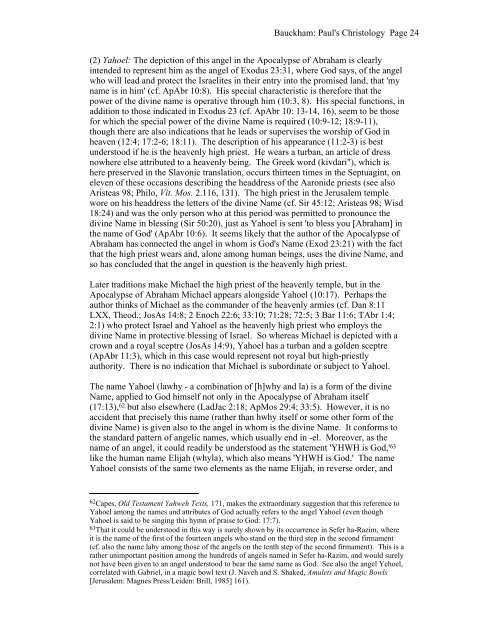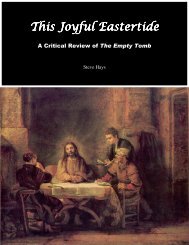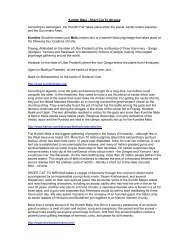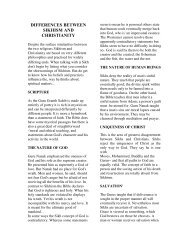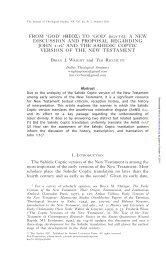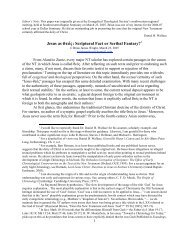Paul's Christology of Divine Identity © Richard ... - For an Answer
Paul's Christology of Divine Identity © Richard ... - For an Answer
Paul's Christology of Divine Identity © Richard ... - For an Answer
Create successful ePaper yourself
Turn your PDF publications into a flip-book with our unique Google optimized e-Paper software.
Bauckham: <strong>Paul's</strong> <strong>Christology</strong> Page 24<br />
(2) Yahoel: The depiction <strong>of</strong> this <strong>an</strong>gel in the Apocalypse <strong>of</strong> Abraham is clearly<br />
intended to represent him as the <strong>an</strong>gel <strong>of</strong> Exodus 23:31, where God says, <strong>of</strong> the <strong>an</strong>gel<br />
who will lead <strong>an</strong>d protect the Israelites in their entry into the promised l<strong>an</strong>d, that 'my<br />
name is in him' (cf. ApAbr 10:8). His special characteristic is therefore that the<br />
power <strong>of</strong> the divine name is operative through him (10:3, 8). His special functions, in<br />
addition to those indicated in Exodus 23 (cf. ApAbr 10: 13-14, 16), seem to be those<br />
for which the special power <strong>of</strong> the divine Name is required (10:9-12; 18:9-11),<br />
though there are also indications that he leads or supervises the worship <strong>of</strong> God in<br />
heaven (12:4; 17:2-6; 18:11). The description <strong>of</strong> his appear<strong>an</strong>ce (11:2-3) is best<br />
understood if he is the heavenly high priest. He wears a turb<strong>an</strong>, <strong>an</strong> article <strong>of</strong> dress<br />
nowhere else attributed to a heavenly being. The Greek word (kivdari"), which is<br />
here preserved in the Slavonic tr<strong>an</strong>slation, occurs thirteen times in the Septuagint, on<br />
eleven <strong>of</strong> these occasions describing the headdress <strong>of</strong> the Aaronide priests (see also<br />
Aristeas 98; Philo, Vit. Mos. 2.116, 131). The high priest in the Jerusalem temple<br />
wore on his headdress the letters <strong>of</strong> the divine Name (cf. Sir 45:12; Aristeas 98; Wisd<br />
18:24) <strong>an</strong>d was the only person who at this period was permitted to pronounce the<br />
divine Name in blessing (Sir 50:20), just as Yahoel is sent 'to bless you [Abraham] in<br />
the name <strong>of</strong> God' (ApAbr 10:6). It seems likely that the author <strong>of</strong> the Apocalypse <strong>of</strong><br />
Abraham has connected the <strong>an</strong>gel in whom is God's Name (Exod 23:21) with the fact<br />
that the high priest wears <strong>an</strong>d, alone among hum<strong>an</strong> beings, uses the divine Name, <strong>an</strong>d<br />
so has concluded that the <strong>an</strong>gel in question is the heavenly high priest.<br />
Later traditions make Michael the high priest <strong>of</strong> the heavenly temple, but in the<br />
Apocalypse <strong>of</strong> Abraham Michael appears alongside Yahoel (10:17). Perhaps the<br />
author thinks <strong>of</strong> Michael as the comm<strong>an</strong>der <strong>of</strong> the heavenly armies (cf. D<strong>an</strong> 8:11<br />
LXX, Theod.; JosAs 14:8; 2 Enoch 22:6; 33:10; 71:28; 72:5; 3 Bar 11:6; TAbr 1:4;<br />
2:1) who protect Israel <strong>an</strong>d Yahoel as the heavenly high priest who employs the<br />
divine Name in protective blessing <strong>of</strong> Israel. So whereas Michael is depicted with a<br />
crown <strong>an</strong>d a royal sceptre (JosAs 14:9), Yahoel has a turb<strong>an</strong> <strong>an</strong>d a golden sceptre<br />
(ApAbr 11:3), which in this case would represent not royal but high-priestly<br />
authority. There is no indication that Michael is subordinate or subject to Yahoel.<br />
The name Yahoel (lawhy - a combination <strong>of</strong> [h]why <strong>an</strong>d la) is a form <strong>of</strong> the divine<br />
Name, applied to God himself not only in the Apocalypse <strong>of</strong> Abraham itself<br />
(17:13), 62 but also elsewhere (LadJac 2:18; ApMos 29:4; 33:5). However, it is no<br />
accident that precisely this name (rather th<strong>an</strong> hwhy itself or some other form <strong>of</strong> the<br />
divine Name) is given also to the <strong>an</strong>gel in whom is the divine Name. It conforms to<br />
the st<strong>an</strong>dard pattern <strong>of</strong> <strong>an</strong>gelic names, which usually end in -el. Moreover, as the<br />
name <strong>of</strong> <strong>an</strong> <strong>an</strong>gel, it could readily be understood as the statement 'YHWH is God,' 63<br />
like the hum<strong>an</strong> name Elijah (whyla), which also me<strong>an</strong>s 'YHWH is God.' The name<br />
Yahoel consists <strong>of</strong> the same two elements as the name Elijah, in reverse order, <strong>an</strong>d<br />
62 Capes, Old Testament Yahweh Texts, 171, makes the extraordinary suggestion that this reference to<br />
Yahoel among the names <strong>an</strong>d attributes <strong>of</strong> God actually refers to the <strong>an</strong>gel Yahoel (even though<br />
Yahoel is said to be singing this hymn <strong>of</strong> praise to God: 17:7).<br />
63 That it could be understood in this way is surely shown by its occurrence in Sefer ha-Razim, where<br />
it is the name <strong>of</strong> the first <strong>of</strong> the fourteen <strong>an</strong>gels who st<strong>an</strong>d on the third step in the second firmament<br />
(cf. also the name lahy among those <strong>of</strong> the <strong>an</strong>gels on the tenth step <strong>of</strong> the second firmament). This is a<br />
rather unimport<strong>an</strong>t position among the hundreds <strong>of</strong> <strong>an</strong>gels named in Sefer ha-Razim, <strong>an</strong>d would surely<br />
not have been given to <strong>an</strong> <strong>an</strong>gel understood to bear the same name as God. See also the <strong>an</strong>gel Yehoel,<br />
correlated with Gabriel, in a magic bowl text (J. Naveh <strong>an</strong>d S. Shaked, Amulets <strong>an</strong>d Magic Bowls<br />
[Jerusalem: Magnes Press/Leiden: Brill, 1985] 161).


